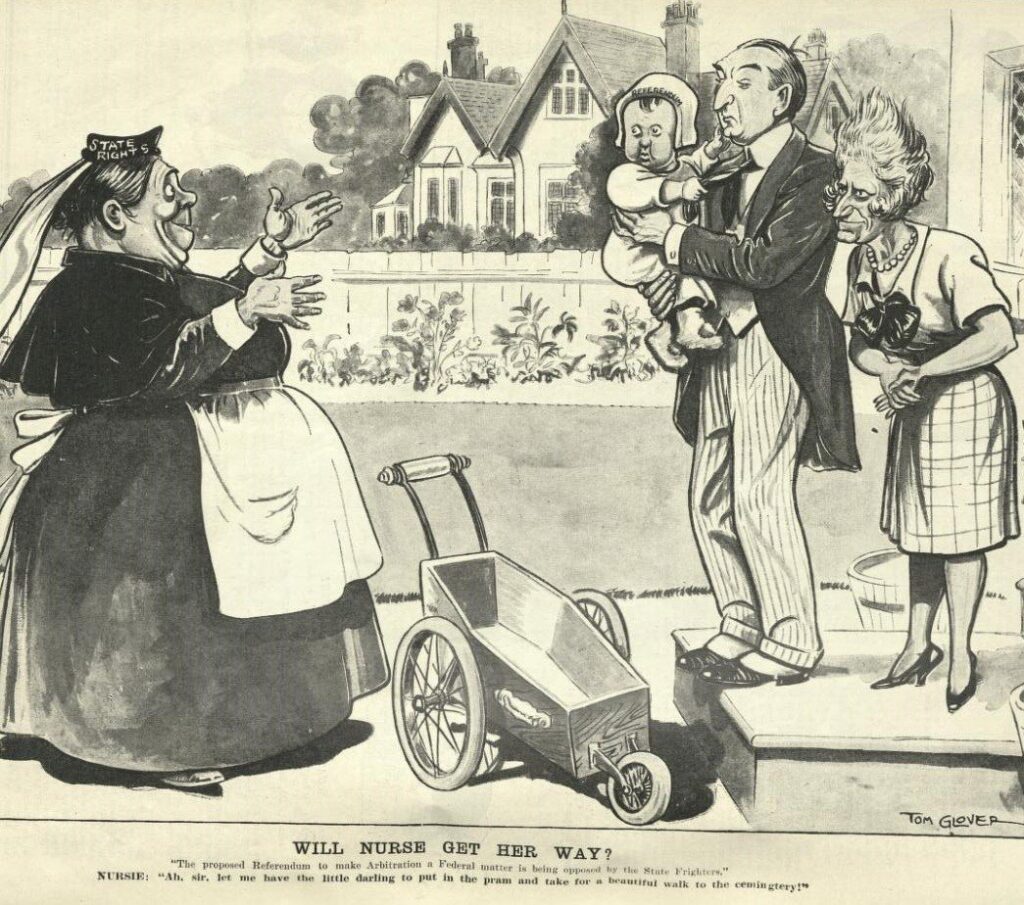Bruce and Page’s referendum baby about to be buried by the nurse of States’ rights. Cartoon from The Bulletin 27 May 1926.
On this day, 4 September 1926, the Australian people vote on two separate referendum proposals seeking to extend the Commonwealth’s powers over Industry and Commerce, and Essential Services. Although the proposals had been raised by the centre-right Bruce-Page Government, the occasion would see a 31-year-old Robert Menzies engage in his first political campaigning trying to defeat them.
The proposals came on the back of a series of industrial disturbances which had accompanied a return to economic prosperity in the mid 1920s. In particular, the militant Seamen’s Union had conducted a protracted campaign over the issue of ‘job control’ – who, how, when and under what conditions ships’ crews should be chosen. When the Commonwealth Arbitration Court decided to deregister the union for persistently disobeying court orders, this prompted a national shipping strike, and a court case in which Menzies and Owen Dixon won a High Court ruling upholding the CAC’s power of deregistration.
However the industrial turmoil was not confined to one industry alone, and while the CAC was allowed to rule on the Seamen’s Union because it involved a dispute crossing the boundaries of more than one State, constitutionally it was still barred from acting on any dispute confined within a State. On the back of a victory at the 1925 election, and with bipartisan agreement given by Opposition Leader Matthew Charlton, Prime Minister Stanley Bruce resolved to remove this restriction via a referendum. Assuming that the bipartisan support would result in an easy ‘yes’ vote, Bruce left time only for a short campaign, but in an occurrence to be frequently repeated in Australian history, he was soon surprised at the strength of the backlash against the move (including that the wider Labor movement would not all fall into line behind Charlton, despite the fact that the Labor platform had long been committed to extending the Commonwealth’s powers in industrial matters).
An important figure in the backlash was Menzies. As a highly successful and sought-after lawyer, he had represented both employers and unions in many industrial legal cases, and his experience with the byzantine industrial relations system led him to conclude that the last thing it needed was further centralisation – if anything he believed that the over-litigation the CAC precipitated had reached the point where it was more damaging than the strikes it had aimed at preventing. In June 1926 he attended a meeting at Scott’s Hotel to establish a Federal Union to ‘oppose the unification proposals now before the country’, and the way his ‘trained legal mind’ described the objectionable nature of the constitutional changes in a ‘clear and lucid manner’ was reported to be a telling factor in getting a number of leading businessmen to sign on as the Union’s committee members.
Menzies himself signed on as a member of the committee directing the ‘no’ campaign in Bruce’s home State of Victoria, and in the course of events he would end up giving prominent speeches at such places as Geelong, Ballarat and Prahran. During the latter he attacked the Government’s plan to delegate industrial issues to tribunals as asking the people to hand over control to an ‘irresponsible, independent and therefore undemocratic body’, and ultimately suggested that it was an assault on the ‘sovereignty of Parliament’. In a time-honoured defence of the liberal concept of subsidiarity Menzies argued that the Federal Parliament was ‘too far removed from the people affected [by smaller scale industrial disputes] to be sensible to their views’, and in a Burkean manner he maintained that the burden of proof was on those bringing forward the proposals to prove that the changes would be beneficial. On another occasion he was quoted as having said that ‘Mr. Bruce’s proposals were analogous to the audacity of the manager of a department in a store, who, having made a hopeless failure of the department, said that there was only one thing to do – make him managing director of the store with absolute authority’.
While Menzies’s statements read as forceful and convincing in the newspaper reports, in presentation they were apparently far removed from the polished political performances he would later be known for. During an interview for Rydge’s magazine conducted in the early 1950s, Menzies would recall that:
‘I took no interest in politics up to 1926, when the Bruce-Page Government advanced proposals to amend the Constitution. I was a well-known junior at the Victorian Bar and was induced to oppose the proposals. In the referendum campaign I made a speech or two. The first was at Prahran, where I took up a stand against the proposal to amend Section 26 (Commerce and Essential Services). I was escorted to the meeting by my uncle [Sydney] Sampson and after it was over I said to him, “well, how did that go?” “It was dreadful,” he replied. “As an address to the High Court it was impeccable. You made all your points and did not repeat yourself. But take my tip. You are not talking to the High Court or lawyers now. You are talking to the public. Make fewer points but establish your argument – and repeat it, always the same argument, but in four or five ways.” It was hard advice for a lawyer to follow – very few lawyers have followed it. That is the reason why such a small proportion of lawyers make a success of public life. They want to be broader, more human. But I tried to act upon it.’
In the event, both referendum questions were comfortably defeated.
Further Reading:
A.W. Martin, Robert Menzies A Life Volume 1 1894-1943, Melbourne University Press 1993.
Sign up to our newsletter
Sign up for our monthly newsletter to hear the latest news and receive information about upcoming events.


